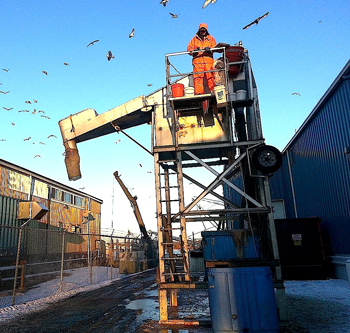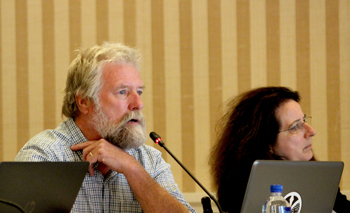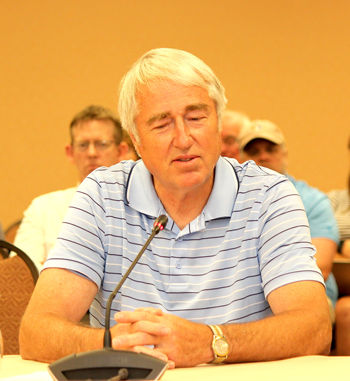Atlantic Herring Spawning Protections
Continued from November 2019 Homepage

Awaiting pump-out of Atlantic herring in New Bedford, Mass. Photo courtesy of the Massachusetts Division of Marine Fisheries.
The original motion included a range of alternatives be developed and analyzed, that includes, at a minimum:
• Spawning closure areas, with options that identified areas around the northern flank of Georges Bank; west of the Great South Channel; and around all sources of data along the northern edge of Georges Bank and around the Great South Channel.
• Spawning closure durations during September and October, with option for duration of 4 weeks, 6 weeks, or 8 weeks.
• Gear/fishery restrictions, with options that included: all gear types fishing for herring; or vessels possessing more than 2,000 pounds of herring.
Glenn Robbins, owner of the herring seiner Western Sea, said protections were long overdue.
“We’ve needed the spawning closures on Georges Bank for years,” Robbins said. The area that was previously wiped out, he said, is now seeing a lot of small herring.
“Last fall there was a tremendous amount of fish that hit the back side of the Cape,” he said. “They were all spawners. They are ripe and running….We’ve done a good job in Maine, but now we’ve got to take care of Georges Bank or all the animals that eat herring will starve. We’re spiraling down.”
“Do you care about protecting spawning or not?” asked tuna fisherman Chris Weiner. “We’re in situation where everyone’s hurting and the majority of the range isn’t protected.”
But NEFMC member David Pierce said the original motion was too specific about what might be appropriate spawning areas as well as duration. Before voting on specific measures, he said, it would be best to have NEFMC’s plan development team review the historical and current scientific research that was compiled this year in a report to NEFMC by the Gulf of Maine Research Institute.
“My sense is the amendment merely kicks the can down the road,” said Terry Stockwell, one of Maine’s representatives on NEFMC. “Many of the potential alternatives outlined in the underlying motion have been analyzed. Other alternatives and options can be added.”
But Maine Department of Marine Resources Commissioner Patrick Keliher said he supported the amendment.

Terry Stockwell, left, one of Maine’s representatives on NEFMC. “My sense is the amendment merely kicks the can down the road. Many of the potential alternatives outlined in the underlying motion have been analyzed. Other alternatives and options can be added.” Fishermen’s Voice photo.
“It’s clear from comments that this will take time to deal with it,” Keliher said. “I think time is on our side, considering the low quotas set for the next several years. I’d rather talk about how to do this properly rather than rushing to specific things in the original motion.”
Jeff Kaelin, representing Lund’s Fisheries in Cape May, N.J., said that bottom tending gear should be considered among the protections, in order to protect herring eggs.
Mary Beth Tooley of O’Hara Corp. in Rockland suggested it might be useful if spawning data could be parsed by month, rather than by year.
The framework action was one of NEFMC’s 2019 priorities to consider offshore spawning protection for Atlantic herring on Georges Bank, according to a NEFMC press release. In order to facilitate the work, NEFMC issued a contract to the Gulf of Maine Research Institute (GMRI) to review historical and current scientific research, as well as other relevant information and previous management actions for spawning herring.
GMRI looked at results from numerous data sources, including the Maine and Massachusetts dockside sampling programs, trawl survey information, larval distribution and diet studies, essential fish habitat for herring eggs, and historical spawning areas. GMRI overlapped the information to start “building a consensus” in identifying where important spawning locations are likely to be and when spawning is likely to occur.
“All data sources combined indicated that spawning activity is most concentrated in two
locations along the northern edge of Georges Bank – one in the west (Nantucket Shoals/Great South Channel) and one in the east (Northern Flank),” the release said. “Spawning occurred primarily in the months of September and October. The investigators also interviewed fishermen and incorporated their comments into the report.”

Glenn Robbins, FV Western Sea. “Last fall there was a tremendous amount of fish that hit the back side of the Cape. They were all spawners. They are ripe and running….We’ve done a good job in Maine, but now we’ve got to take care of Georges Bank or all the animals that eat herring will starve. We’re spiraling down.” Fishermen’s Voice file photo.
Key takeaways from industry interviews that were part of GMRI’s work included the general view that spawning was too variable to pinpoint exact locations and times. Industry members also said that spawning herring are relatively rare in their catches.
“This agrees with data,” GMRI said.
Additional industry observations included:
• Areas fished are not conducive to spawning; industry believes herring spawn in shoal water, along the northern edge of Georges Bank, from August through November.
• Many would like to see more sampling to better identify spawning, including tagging, otolith work, and surveys utilizing multiple gears, with industry involved.
• There were some fears that herring have shifted toward Canadian waters.
• One group said that haddock are mixed in with the catch and are likely preying upon eggs.
• Abundance of river herring was also a concern, as competition for resources.
“It is a work in progress,” NEFMC staffer Deirdre Boelke said of a working draft of the framework action’s discussion document. “Hopefully by the December meeting we’ll have a more complete and final document.”
NEFMC expected to be working through 2020 to fully develop and analyze the alternatives for the action. In the end, the amended motion passed unanimously.
